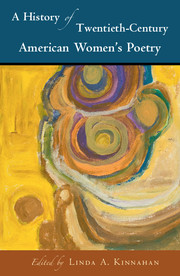Book contents
- Frontmatter
- Contents
- List of figures
- List of contributors
- Preface
- Acknowledgments
- PART I MAPPINGS AND CHRONOLOGIES
- 1 Critical Mapping I: The Category of the “Woman Poet” – An Introduction, by Way of Mapping
- 2 Critical Mapping II: Reading American Poetry by Women
- 3 Chronology I: American Women Poets, 1900–1950
- 4 Chronology II: American Women Poets, 1950–2000
- PART II ETHNICITY, RACE, AND IDENTITY
- PART III MATERIAL FORMATIONS
- PART IV LINEAGES, TIES, AND CONNECTIONS
- PART V FORM, LANGUAGE, AND TEXT
- PART VI CODA
- Bibliography
- Index
3 - Chronology I: American Women Poets, 1900–1950
from PART I - MAPPINGS AND CHRONOLOGIES
Published online by Cambridge University Press: 05 June 2016
- Frontmatter
- Contents
- List of figures
- List of contributors
- Preface
- Acknowledgments
- PART I MAPPINGS AND CHRONOLOGIES
- 1 Critical Mapping I: The Category of the “Woman Poet” – An Introduction, by Way of Mapping
- 2 Critical Mapping II: Reading American Poetry by Women
- 3 Chronology I: American Women Poets, 1900–1950
- 4 Chronology II: American Women Poets, 1950–2000
- PART II ETHNICITY, RACE, AND IDENTITY
- PART III MATERIAL FORMATIONS
- PART IV LINEAGES, TIES, AND CONNECTIONS
- PART V FORM, LANGUAGE, AND TEXT
- PART VI CODA
- Bibliography
- Index
Summary
In no period before and rarely since have women poets had greater success and influence than in the first half of the twentieth century in the United States. During the 1910s and 1920s, large numbers of women took leadership roles in many areas of art and literature – founding museums, editing little magazines, writing literary columns for newspapers, running theaters and theater guilds, and publishing fiction and poetry. While this phenomenon also occurred in Europe, including Britain, and elsewhere in the Americas, it was most prevalent in the United States, thanks to its history of coeducational public schooling, nineteenth-century founding of women's colleges and coeducational universities, and progressive support for women's financial and legal independence following the American Civil War. Among many others, Harriet Monroe, Gertrude Stein, H.D., Marianne Moore, Amy Lowell, Edna St. Vincent Millay, Mina Loy (a British poet who published with American editors and eventually became a citizen), Georgia Douglas Johnson, Lorine Niedecker, Muriel Rukeyser, Gwendolyn Brooks, and Elizabeth Bishop individually and cumulatively had a powerful impact on the directions of poetry in the twentieth century.
The popularity and critical success of female poets in the 1890s and first decade of the twentieth century helped pave the way for these and other women to write with the confidence that their work would be taken seriously and that they could contribute to the elite field of poetry on an equal basis with men. From the popular posthumous publication of Emily Dickinson's poems in 1890, 1891, and 1896 to the work of Louise Chandler Moulton, Ella Wheeler Wilcox, Josephine Peabody, Elaine Goodale (Eastman), E. Pauline Johnson, Alice Dunbar-Nelson, Angelina Grimké, and Mary McNeil Fenollosa, poetry by women was increasingly visible. In an 1890 article, editor Helen Clarke wrote: “As to the paucity of literary achievement imputed to woman … we have already had an Emma Lazarus to put with Emerson and Whitman in the front rank of genuinely original American writers,” and in 1896 Rupert Hughes wrote that “[Dickinson,] … Walt Whitman and Poe are this nation's most original contributions to the world's poetry.” Twentieth-century female poets could therefore look to an immediate past in which women were openly praised for writing “original” verse.
Female poets produced and edited every category of poetry.
- Type
- Chapter
- Information
- A History of Twentieth-Century American Women's Poetry , pp. 41 - 55Publisher: Cambridge University PressPrint publication year: 2016



